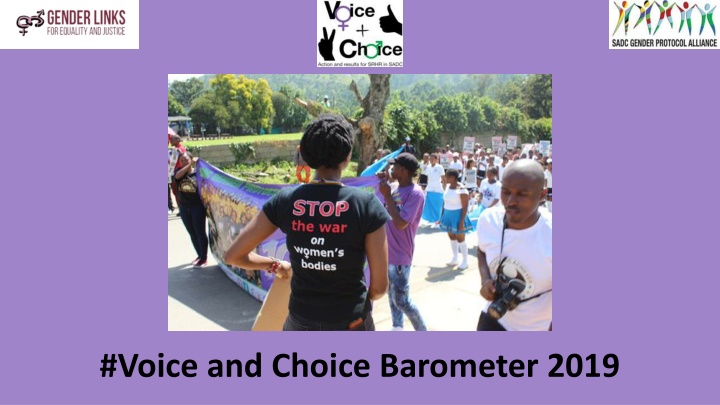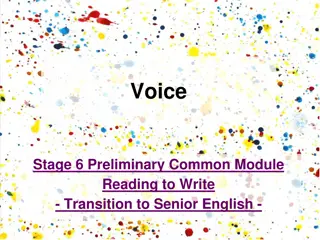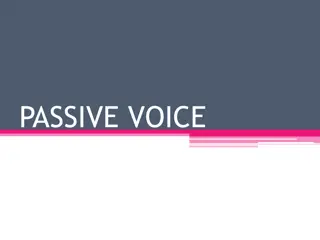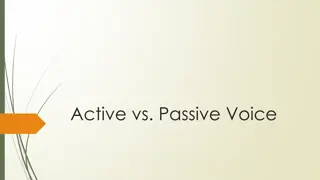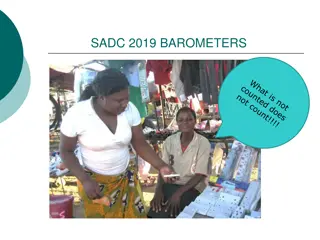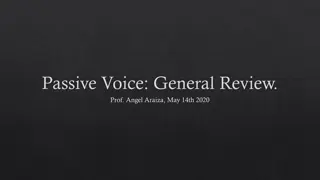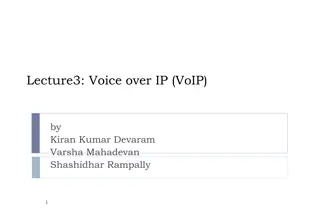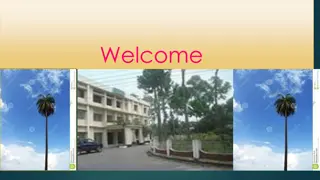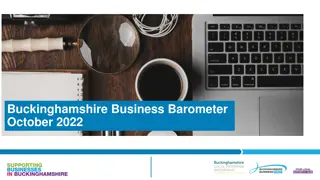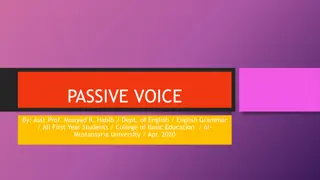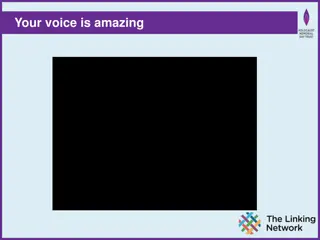#Voice and Choice Barometer 2019
Analyzing the 2019 #Voice and Choice Barometer report. Explore key findings, insights, and trends related to voice and choice in various contexts. Gain a deeper understanding of the current landscape and implications for decision-making.
Uploaded on Feb 15, 2025 | 0 Views
Download Presentation

Please find below an Image/Link to download the presentation.
The content on the website is provided AS IS for your information and personal use only. It may not be sold, licensed, or shared on other websites without obtaining consent from the author.If you encounter any issues during the download, it is possible that the publisher has removed the file from their server.
You are allowed to download the files provided on this website for personal or commercial use, subject to the condition that they are used lawfully. All files are the property of their respective owners.
The content on the website is provided AS IS for your information and personal use only. It may not be sold, licensed, or shared on other websites without obtaining consent from the author.
E N D
Presentation Transcript
Why #Voice and Choice? Why #Voice and Choice? The #Voice and Choice campaign, launched in August 2018, builds on the global and regional momentum on SRHR. It moves the gender justice agenda from the Post 2015 era to include individual and collective voices to advocate for change. The agenda is driven by citizens demands and voices. By improving citizens wellbeing, institutions and other stakeholders are building a critical citizenry that can hold governments accountable.
#Voice and Choice Barometer #Voice and Choice Barometer For ten years the Alliance has produced the Southern African Gender Protocol Barometer, tracking performance of the 15 SADC countries against the provisions of the 2008 SADC Protocol on Gender and Development, updated in 2016. The 2019 #VoiceandChoice Barometer takes a radical departure from the past in that: It will focus on a specific cross cutting theme SRHR. It will measure progress against several relevant instruments, not just the SADC Gender Protocol. These include the SDGs, ICPD, the Maputo Protocol, and the SADC SRHR strategy.
Methodology Methodology The GL and the Alliance comprehensive review of SRHR laws and policies in 15 SADC countries. Analysis of normative frameworks. Developing indicators quantitative measures, 100, including 12 covered in the SADC SRHR Strategy. Each chapter begins with a table of key indicators for which data could be reliably obtained across the 15 countries. The three primary sources of these indicators are: Empirical data from credible sources to establish baselines and measure progress. This comes from UN Agencies such as UNAIDS, the WHO; UNFPA and UNESCO. Public attitudes: Each year Alliance partners administer the Gender Progress Score (GPS) or Attitudes Survey that gauges prevailing gender attitudes amongst the public using a 25-question survey. Eight of these questions are relevant to SRHR. The Gender Responsive Assessment (GRA) of Constitutions and Laws: The GRA is a peer review of Constitutional rights, special measures, domestic legislation, equality in accessing justice, marriage and family rights, persons with disabilities, widows and widowers rights, the girl and the boy child (Articles 4 to 11 of the SADC Gender Protocol).
Indicators from SADC SRHR Strategy Percentage reduction in new HIV infections, females 15 24. Mother to child transmission of HIV Green Yellow Red No data % Green 8 4 2 1 53% 7 5 2 1 47% Adolescent birth rate, 10 19 years of age Existence of laws and policies that allow adolescents to access SRH services without third party authorisation. Unmet need for family planning (contraception). 6 6 3 40% 6 9 40% 6 6 2 1 40% Minimum legal age of consent to marriage, 18 years for all irrespective. 5 4 6 33% Proportion of ever-partnered girls and women (ages 15 and above) subjected to physical and/or sexual violence by a current or former intimate partner, in the last 12 months. Neonatal mortality, institutional Maternal mortality Legal status of abortion Percentage of annual budgets allocated to health sector Percentage of condom use with last high-risk sex among adolescent girls and young women aged 15 24 years of age. 4 8 3 27% 3 2 2 2 8 7 4 6 1 4 20% 13% 13% 13% 12 9 1 10 1 3 7%
Sexual and reproductive health Sexual and reproductive health Menstrual health is on the regional agenda. A major concern is the lack of access to basic sanitation in most SADC countries. There is 50% or less access to basic sanitation in ten countries. Only two SADC countries, Seychelles and Mauritius, meet the global target of less than 70 deaths per 100 000 live births for pregnant women and girls. The maternal mortality rate is ten times higher than this in the DRC. Health budgets remain below the recommended Abuja Declaration goal of 15% expenditure on health. Only eSwatini and Madagascar meet this target. SRHR services need to be integrated into universal health care (UHC).
Adolescent SRHR Adolescent SRHR Most SADC countries have a Comprehensive Sexual Education (CSE) programme in place that meets or is in the process of being aligned to international standards but implementation, monitoring and evaluation is still weak. Only six SADC countries (DRC, Lesotho, Madagascar, Malawi, South Africa and Zambia) have stand alone ASRHR policies or strategies. Only five countries (Madagascar, Mozambique, Namibia, South Africa and Tanzania) do not require parental consent for adolescents to access SRHR services. Tanzania s President John Magufuli has banned readmission of girls who get pregnant in school.
Safe abortion Safe abortion The ability of a woman or girl to safely decide not to continue a pregnancy may be the key that unlocks numerous opportunities in life, including education, employment, financial security and good health. The SADC SRHR Strategy highlights that 24% of all pregnancies in Southern Africa end in abortion, with the vast majority of these unsafe and a major contributor to maternal mortality. There are only two SADC countries in which abortion is available on demand in the first trimester (South Africa and Mozambique).
HIV and AIDS HIV and AIDS People who know their HIV status on ARVs 100 95 95 95 95 95 95 95 95 95 95 93 92 91 88 90 85 80 79 79 78 78 77 80 76 76 76 75 73 72 71 70 69 70 66 63 62 61 60 59 60 50 45 38 40 32 30 25 20 13 10 5 0 Botswana Eswatini Mauritius Namibia Tanzania Zambia Zimbabwe Malawi DRC Mozambique Madagascar Lesotho South Africa Angola Women Men Children
Gender Gender- -based violence based violence Data gaps a major challenge. Only seven SADC countries have undertaken dedicated GBV studies to determine the extent and effectiveness of responses to GBV. The region needs to identify effective surveillance systems to track GBV on an ongoing basis. Policy and legislative rich area implementation a key challenge. A study on TV media in South Africa shows that this medium lacks diversity, balance and sensitivity in the coverage of gender violence. Only 16% of TV news stories on GBV mentioned where survivors can go for help.
Harmful practices Harmful practices The average regional score for the Gender Responsive Assessments (GRA) of Constitutions and laws in SADC undertaken by peer review groups in every SADC country as part of the 2019 Barometer is just 57%. The lowest rated area (average 49%) is access to justice. While all SADC countries meet the requirement of the minimum age of 18 for marriage for men, only three countries (Malawi, Mozambique and South Africa) stipulate 18 as the minimum age of marriage for women and men with no exceptions. Female genital mutilation, discrimination of widows and accusations of witchcraft still prevalent. in 1998 has not ended the practice.
Sexual diversity Sexual diversity This ground-breaking chapter expands the narrow focus on decriminalising homosexuality to include protections and the recognition of LGBTI rights. Homosexuality is now decriminalised in five (or about one third) of Southern African countries South Africa, Seychelles, Angola, Mozambique and DRC. Only South Africa allows for same sex marriages and civil unions. Three countries (Mauritius, Namibia and South Africa) allow LGBTI persons to change their gender markers. Mauritius and South Africa ban conversion therapy, which is known to cause extensive physical and psychological damage. Only one SADC country, Angola, has hate crimes legislation that explicitly protects LGBTI persons from violence and discrimination. Only South Africa has laws in place for protection of intersex people. There is a lack of targeted SRHR services for LGBTI people and a dearth of data to guide informed strategies.
What next? What next? Sharing the findings with government, SADC, NGOs and other stakeholder. Develop strategic interventions to address gaps. Hold governments accountable using the 100 indicators and the SADC SRHR Strategy. Engage with local government to improve services.
Female and male latrines at a secondary school in Mwanza, northeastern Tanzania. Many students told Human Rights Watch that they had to use dirty and congested pit latrines. SADC Regional Indicative Strategic Development Plan (RISDP) 2015 2020 of a shared future within a regional community that will ensure economic well-being, improvement of the standards of living and quality of life, freedom, social justice, peace and security for its peoples.
